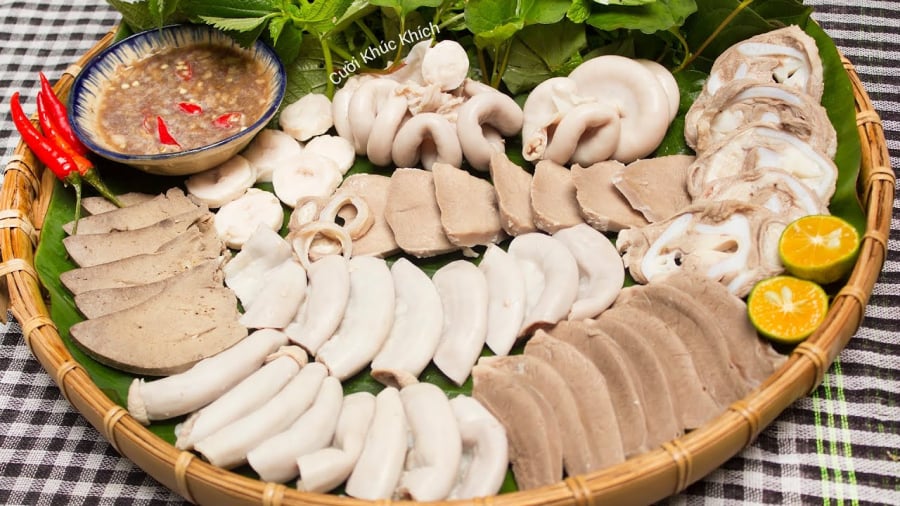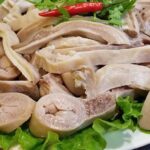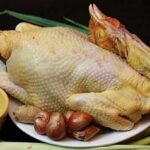Pork innards are a humble and familiar dish, but to ensure they retain a crunchy texture and don’t become tough or soggy, follow this trick after boiling. Don’t rush to slice the innards immediately after boiling; instead, dip them in a special liquid for perfect results. Here are the detailed instructions:
Ingredients
Pork innards: 500g
Ginger: 1 small root
Salt: 1 teaspoon
Vinegar: 2 tablespoons
White wine: 1 tablespoon
Ice-cold water: 1 large bowl
Lemon: 1 fruit

How to Make Crunchy Boiled Innards
Step 1: Prepare the pork innards
Rinse the pork innards under running water, then rub them with salt and vinegar to neutralize any unpleasant odors. Turn the innards inside out and scrape away any slimy membrane. Boil some water, add a tablespoon of white wine and a few slices of ginger, and blanch the innards for 1-2 minutes. Remove and rinse with cold water.
Step 2: Boil the innards
In a pot of boiling water, add a teaspoon of salt and a few slices of ginger. Place the innards in the pot and simmer over medium heat. The boiling time depends on the type of innards:
Small intestine: 15-20 minutes
Stomach: 25-30 minutes
Heart, liver: 20-25 minutes
Check for doneness by piercing the innards with a skewer; if no pink liquid comes out, they are ready.
Step 3: The secret dipping liquid for crunchiness
Prepare a bowl of ice-cold water and add 1-2 tablespoons of lemon juice (or vinegar). As soon as the innards are cooked, remove them from the pot and plunge them into the ice-cold lemon/vinegar water. Soak for about 5-7 minutes. The ice water causes the innards to contract quickly, preserving their crunchiness, while the lemon or vinegar brightens their color, neutralizes odors, and adds firmness.
Step 4: Slicing and presentation
After soaking, remove the innards from the liquid and let them dry. Slice them into thin, bite-sized pieces and arrange them on a plate. Serve with a dipping sauce made from fermented shrimp paste, lemon, and chili, or fish sauce with ginger to enhance the flavor.

Tips for Boiling Crunchy Innards
Do not overboil the innards, as this will make them tough or mushy. The ice water must be very cold; add a few extra ice cubes to maintain a low temperature. For even whiter and crunchier innards, you can add a little bit of alum to the soaking liquid (1/4 teaspoon of alum dissolved in 1 liter of ice water).
Step 5: The final product
After boiling and dipping in ice-cold lemon water, the pork innards will be deliciously crunchy, snowy white, and odor-free. Serve with fresh herbs and fermented shrimp paste for a mouthwatering experience. The secret lies in the simple yet surprisingly effective step of dipping the innards in ice-cold lemon water!
Good luck with this crunchy boiled innards recipe! If you need more recipes or cooking tips, feel free to ask me anytime!
The Secret to Boiling Crabs to a Beautiful Red Hue, With Tender and Flavourful Meat, Without Breaking the Claws.
Crabs and crayfish are beloved seafood delights for many, thanks to their succulent and sweet meat, packed with a punch of flavors. Those who fancy seafood will undoubtedly relish the steamed crab/crayfish, a mouth-watering delicacy. The mere thought of indulging in this delectable dish, slowly peeling off the shell and dipping the tender meat into a spicy mustard sauce, is enough to tantalize the taste buds of any seafood enthusiast.
Master Chef’s Secret: Plunge the Chicken in a Broth of Bones and Marrow for a Succulent, Tender Feast
By simply adding an extra step to your boiled chicken preparation, you can ensure evenly cooked, moist, and perfectly tender meat. After boiling, let the chicken rest and soak in the broth. This process ensures that the meat is thoroughly cooked, preventing any red bones or raw meat surprises. It’s a simple yet effective technique to guarantee a delicious and perfectly prepared chicken dish every time.



































